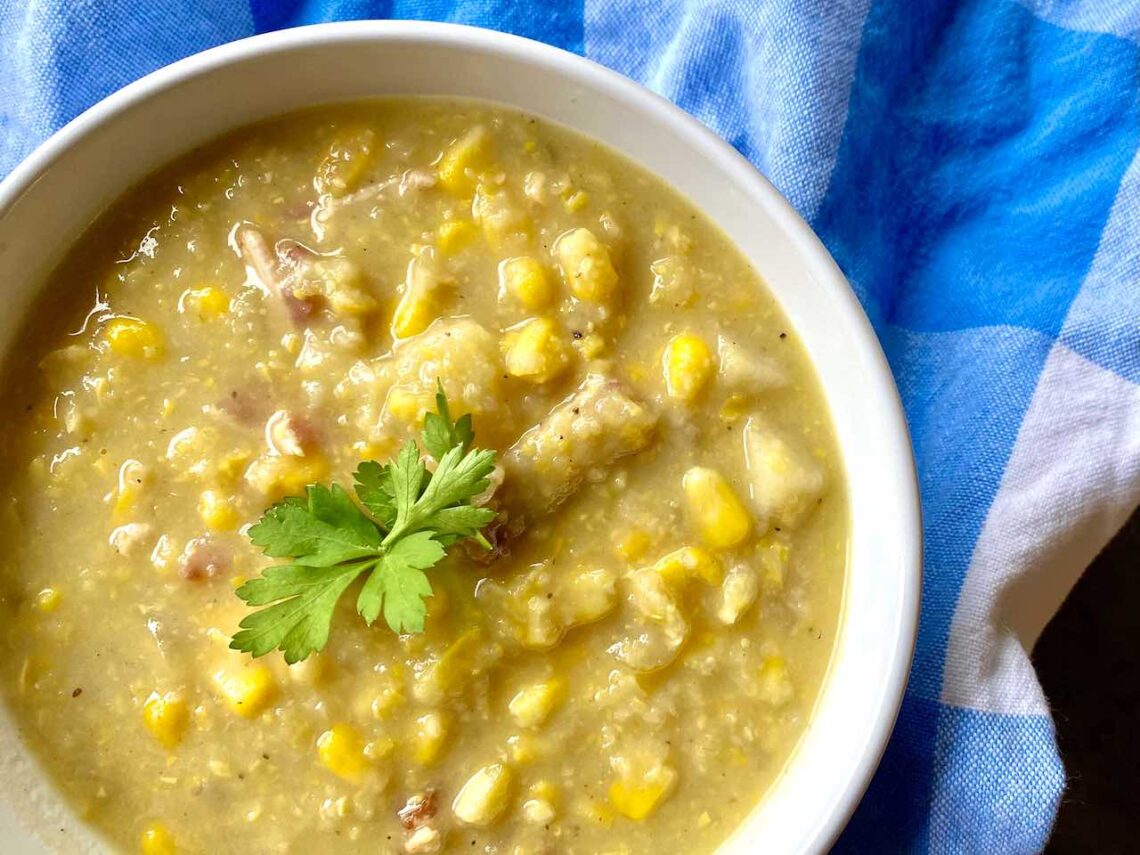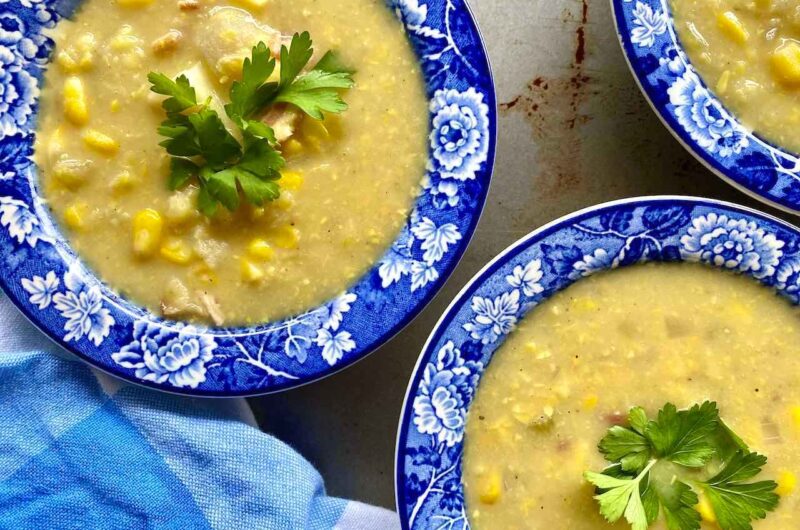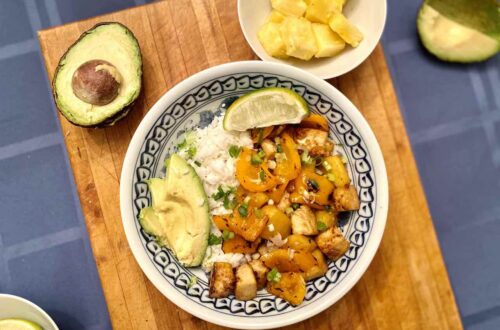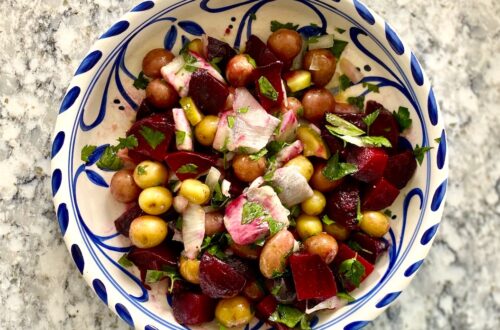
Dorie’s Perfect Corn Chowder
It’s early February, and snow has covered the ground for weeks. Bundled up in scarves, hats, gloves, and snow boots, it’s hard to remember the feel of those late summer days when I first made this chowder, when the wind howled against the window, rain poured down, and I cuddled up with a book and a cup of tea. While those days just at the end of corn season are perfect for corn chowder, this recipe makes a hearty and comforting meal at any time of year. So let’s enjoy corn chowder as it gets colder and colder (and colder), since I don’t want to wait half a year to share it with you. (This recipe works great with frozen corn, so it really is perfect for the whole year – including these ice-cold January days.)
I’ve always loved all kinds of chowder, although clam chowder is a no-go for me (I’m allergic to clams). I comfort myself with lobster bisque, fish stew, and, of course, this delicious corn chowder. The source of its deliciousness is bacon, so for those who don’t eat pork, skip this recipe. (Please don’t try to make it vegetarian – it just won’t sing in the same way.) Though it’s not a topic I want to know more about, I am going to use this post to discuss pork production in the US.
In my first post on pork, I discussed market consolidation in the pork industry and the environmental harms that come from pork production. Today I want to get into something that I am even more reluctant to learn or write about: how pigs are raised in these factory farms. Recently, I’ve been on a reading kick of explicit and gruesome food books: Jonathan Safran Foer’s Eating Animals; Michael Pollen’s The Omnivore’s Dilemma; Louise Gray’s The Ethical Carnivore, about a woman who spends a year eating only meat she has killed herself – you get the picture.
Factory farming is truly horrifying. There’s a reason it’s kept out of sight from consumers – we don’t want to know how our food is actually produced. But we can’t simply turn away and ignore the reality of our food supply chains. Today, pork is the most widely eaten meat in the world and the third most consumed meat in the US, where it represents a $23 billion industry.
Everything I’ve read on pork production begins by explaining how intelligent pigs are. Although it’s a cliché, I think it’s worth repeating. Pigs are really, really smart. They’re smarter than dogs. They create hierarchies, play with toys, and have long-term memories. It’s in their nature to wander, sniff, dig, and explore. Yet we ignore this intelligence in favor of mass production. Ninety-seven percent of hogs are raised on factory farms where they are held in small spaces. Pigs aren’t meant to live so close together, and are often distraught in these factory farms, resulting in their biting each other’s tails – which is why piglets’ tails are cut off at birth, often without pain relief. These close quarters mean pigs often have “scrapes and lesions,” which, when infected, become cysts and abscesses. Because of these living conditions, pigs in the US are fed an insanely high level of antibiotics, which can lead to antibiotic-resistant bacteria.
Additionally, most pregnant pigs are held in “gestation crates,” containers that don’t allow mother pigs to move, much less turn around. Studies have shown that pigs in gestation crates often have “weakened bones, overgrown hooves, urinary tract infections, and repeated bar biting—behavior often indicating psychological distress.” This is no surprise. In addition to not allowing pigs to move or turn around, the containers have slats at the bottom to let the pig’s waste fall below. That means the smell from their own feces remains and they are forced to defecate where they live – something that is against a pig’s nature.
The brutality of hog farming has long been known, even if those outside the industry can rarely see inside hog sheds. In 2018 California passed a ballot initiative that requires improved conditions for all pork sold in California. As of January 1, 2022, breeding pigs (as well as veal calves and laying hens) must be able to lie down, stand up, fully extend their limbs, and turn around. Because California plays an outsize role in US commerce, representing 15 percent of the US pork market, the pork industry has a real incentive to comply with the law. Yet as of August, 2021, only 4 percent of pork producers (about 2,600 out of 66,0000 producers) had met the space requirement for breeding pigs.
While the California law is a step in the right direction, it touches only one of the many, many issues with pork production. It doesn’t deal with the large amounts of waste (a nice term for it), the harm to people living near hog sheds, the impact on global warming, or many of the other ways in which hogs are treated cruelly while being raised for our food. Honestly, by the time I finished researching and writing this post, I was no longer certain if I would eat this chowder. So to anyone who actually made it to this far, let me know what you decide to do. And for everyone who skips the informational parts of this blog and goes straight to the recipes … enjoy the chowder.
Dorie’s Perfect Corn Chowder
Course: Uncategorized4
servings1
hourIngredients
1 large yellow or white onion, finely chopped
2 celery stalks, finely chopped
2 garlic cloves, minced
¾ of a pound (340 grams) potatoes, peeled and cut into ¼-inch pieces
1 (16-ounce) bag of frozen yellow corn
1 tablespoon olive oil
1 tablespoon butter
Fine sea salt and freshly ground pepper
4 cups chicken broth
4 slices of bacon
2 tablespoons white wine (optional)
½ cup milk or half-and-half
Minced fresh herbs, such as chives, parsley and/or basil (optional)
Directions
- Chop the onion, celery, garlic, and potatoes. Split the chopped onions, chopped celery, chopped potatoes, and minced garlic in half and place in two separate bowls. Set one bowl, with half of the ingredients, aside.
- Add half of the frozen corn to each bowl.
- Heat the olive oil and butter in a Dutch oven or other heavy-bottomed pot over medium-low heat. Add the first bowl of vegetables (onion, celery, garlic, potatoes, and corn) to the pot, season with salt and pepper, and sauté for about 10 minutes, until the onions and celery are soft.
- Add the chicken broth, bring to a boil, and simmer for about 20 minutes, until the potatoes are cooked. (It’s done when a fork or knife goes into a piece of potato easily.)
- When the potatoes are cooked, use an immersion blender to emulsify the soup to a smooth texture. Keep simmering it while you make the bacon and cook the rest of the vegetables.
- While the soup is simmering, cook the bacon in a separate pan. When cooked, set aside on a plate lined with paper towels.
- Add the second bowl of vegetables to the pan with the remaining bacon fat. It’s best to have a thin layer of fat – about 1/8-inch or so – in the pan to sauté the remaining vegetables. Pour out any excess fat. You want the flavor from the bacon, but you don’t want to eat all of that fat.
- Sauté the vegetables for about 10 minutes, until soft. Add the vegetables to the soup and allow it to simmer for another 10 minutes. Then add the white wine and milk. Make sure it doesn’t boil at this point. Serve with herbs





